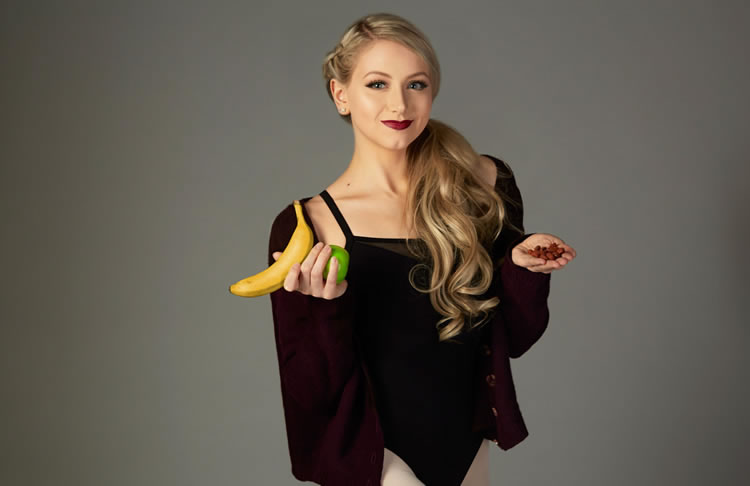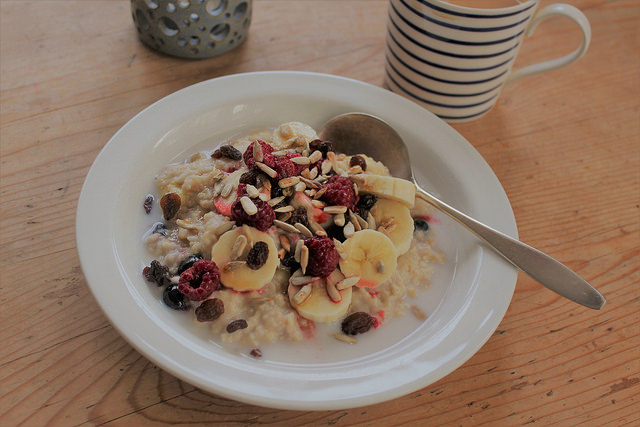5 Dancer-friendly Foods
By Move Dance on 23rd Jan 2018
5 Foods for a Dancer

Misty Copeland’s book Ballerina Body delves into the diet of the successful ballerina, which uncovers some sweet treats that you might not expect. Copeland ensures she never skips breakfast, which is one of the best tips we can recommend. If you’re a dance student or professional dancer in particular, you’re going to be on the go all day burning a high number of calories. That’s why it’s important to “give your body what it needs”, as our model Ella Redhead rightly demands, and ensure that you cut the fasting early in the day.
So, what are the best foods for a dancer? That means something nutritious that you can snack on between classes when your stomach starts to growl and puts you off that pose. Copeland’s daytime staples are salads, fruits, carbs, and nuts, which is similar to that of Alison Eager. We’ve teamed up with Alison, a third year ballet student and Move Dancewear model, to get an insight into the real life and eating habits of a dancer.
1 Why oats are good for breakfast

An original photo by Heather.
Slow-releasing energy foods are a good start to your dancing day. Alison always starts the day with homemade porridge so she can ensure the correct amount of natural goodness - like berries, honey and pumpkin seeds - goes into it. A tip from Alison is to homebake your favourite treats to make a healthier version. For example, Alison makes granola bars that are packed with oaty goodness, and also give a quick sugar hit for an energy spike. You can make other oat snacks by using rolled oats and peanut butter that packs energy and protein in one, but be aware that you won’t feel an instant surge of energy. You would therefore need to consume oats at least 90 minutes in advance of exercise to get the full benefit.
2 Why are nuts & seeds a popular snack for a dancer?

An original photo by I_Nneska.
Apart from all the other things that we believe are a dancer’s best friend (a great dance bag, strong legs and tiger balm), protein is certainly a dancer’s diet’s best friend! Your muscles desperately crave protein in order to recover and re-group after dance class and training. If it’s lean muscles that you’re after, ensuring you consume the correct amount of protein for your body type is essential. Nuts are an easy way to add a little protein to your day whilst being a dancer on-the-go. Unsalted, natural nuts like walnuts, peanuts, and almonds are the best type of nutty snack for a dancer. A tablespoon of peanut butter a day will also give you a salty, tasty treat, but again you need to be careful that you choose a natural blend with no hydrogenated fats. Pumpkin seeds are packed full of essential vitamins and protein - another easy way to care for your body on-the-go!
3 What fruit is best for keeping fit?
 \
\
An original photo by Stacey Spensley.
Dried fruit has the water removed from it during preparation so it has slightly more calories than its fresh alternative. Saying that though, dried fruit has a higher vitamin percentage than a fresh fruit counterpart. Bananas are great for potassium and making you feel full, but sometimes you might want something lighter on the stomach like berries. Our dancer’s favourites are fruits like dried apricots, dried pineapple and raisins. Dried coconut will also give you a creamy flavour boost if you’re looking for something more indulgent.
But how many times have you forgotten your water bottle, or panicked that you’re not hydrated enough? Smoothies are great for on-the-go and can help to keep you hydrated whilst getting your necessary fruit intake - choose a banana-based smoothie for more energy. Alison always keeps a few packs of hydration powder in her dance bag during show season, which is designed to replace the necessary electrolytes in your body (lost through sweat) and keep you feeling energetic.
Remember: sugar is a carb, but natural fruit as opposed to those processed carb-heavy crisps and biscuits is certainly a better option.
4 Eat your greens!

An original photo by Dev Jimenez.
Tupperware and organisation are probably also a dancer’s best friend (you’ve got tonnes of best friends as a dancer!). If you can plan in time to do meal prep after class whilst you’re giving your muscles a rest, you’ll definitely benefit from having healthy options come lunchtime. Spinach is low in fat and high in green, which is always a good option when choosing a vegetable. It’s rich in iron which means incorporating spinach in your diet promotes healthy blood cells and assists in transporting oxygen around your body - perfect for during and after an intense dance routine!
5 Why is fish healthy to eat?

An original photo by Harald Groven.
Fish is rich in omega 3, protein, and good fats. It helps with building lean muscles and giving your body what it needs, particularly if you choose oily fish like salmon. If you’ve sorted your daily intake of greens, you’re going to want a good carbohydrate source to further fuel your day. Alison has recently discovered a love of sushi, and she prepares this for lunch by adding extra rice or other carbs on days that she knows are going to be really active.
So, what’s for dinner? You’ve finished the day’s classes and you’re looking for a satisfying, rewarding meal. Alison stresses the importance of “listening to your body” at the end of a tough dancing day and making sure that you fuel your muscles ready for the next day ahead. Fish, or another high-protein source, is ideal to support your body’s recovery. You can pair this with carbs like Alison, and even pile on more protein to correlate to the intensity of your day. Copeland is in fact pescatarian, which is a testament to the health and nutrition benefits of eating fish!
A dancer’s secret

An original photo by Lee McCoy.
Do you love chocolate? So do our models! You might not think that such a slender physique can be maintained whilst eating chocolate, but it has surprising benefits for a dancer. Dancing isn’t just about staying as skinny as possible, it’s about giving your body what it needs. Our models always carry a bar of chocolate or some other treat in their dance bag as an emergency sugar stash. If their energy levels are feeling low after a particularly high-intensity class, a few squares of chocolate boosts them for a short period of time. If you want to eat chocolate and feel a little healthier and less guilty, dark chocolate (high cocoa percentage) is always an option! Be aware, though, that you need to ensure you eat the correct amount of calories in the day for your body type to avoid a post-chocolate sugar crash.
This blog post is not offering nutritional advice and guidelines. We are highlighting healthy foods that can benefit a dancer. We are not advising that a person must eat the suggested foods. Please also be aware that some foods on the above list are allergens. If you want nutritional advice, please ask your dance teacher or a nutritionist.

